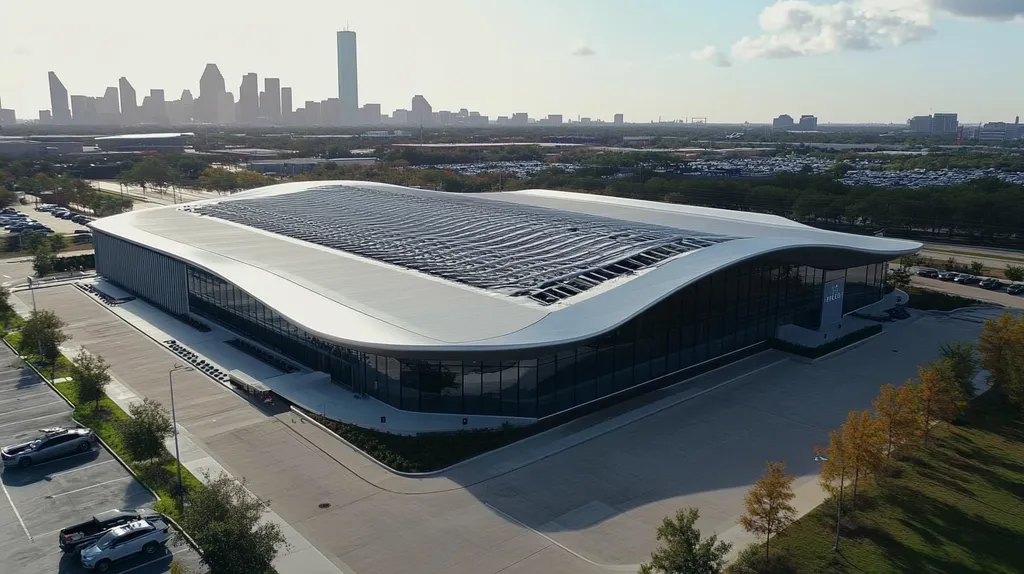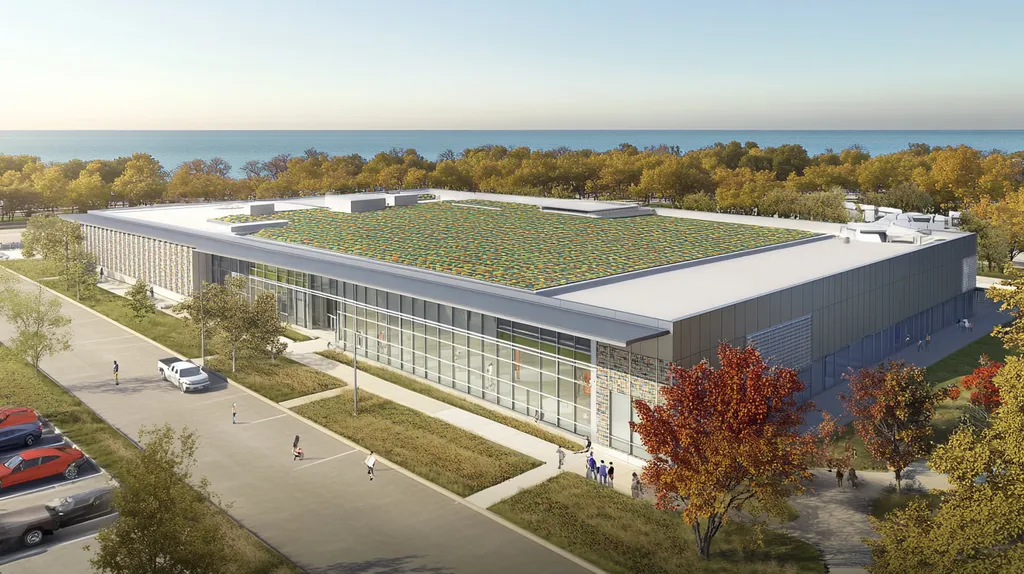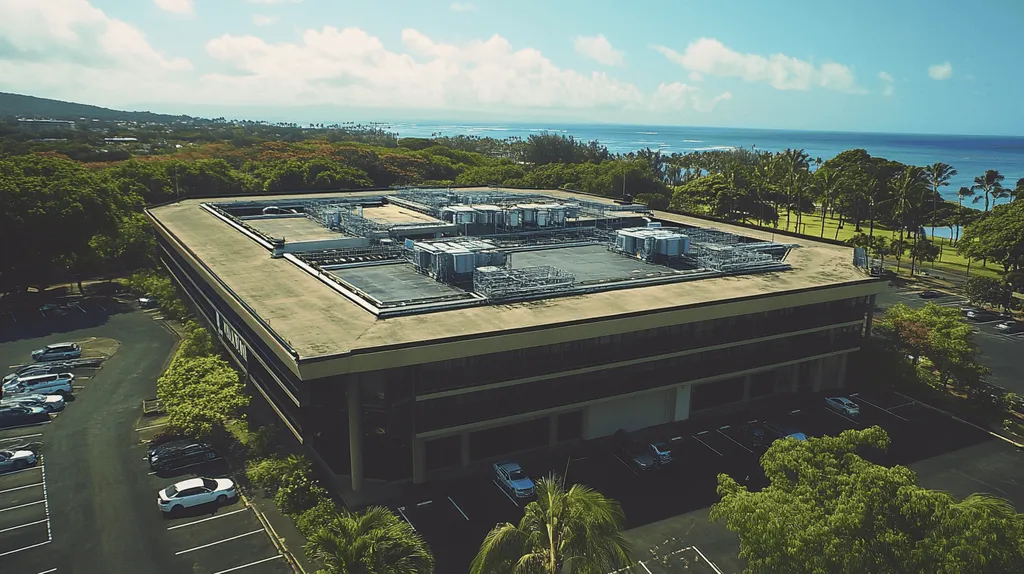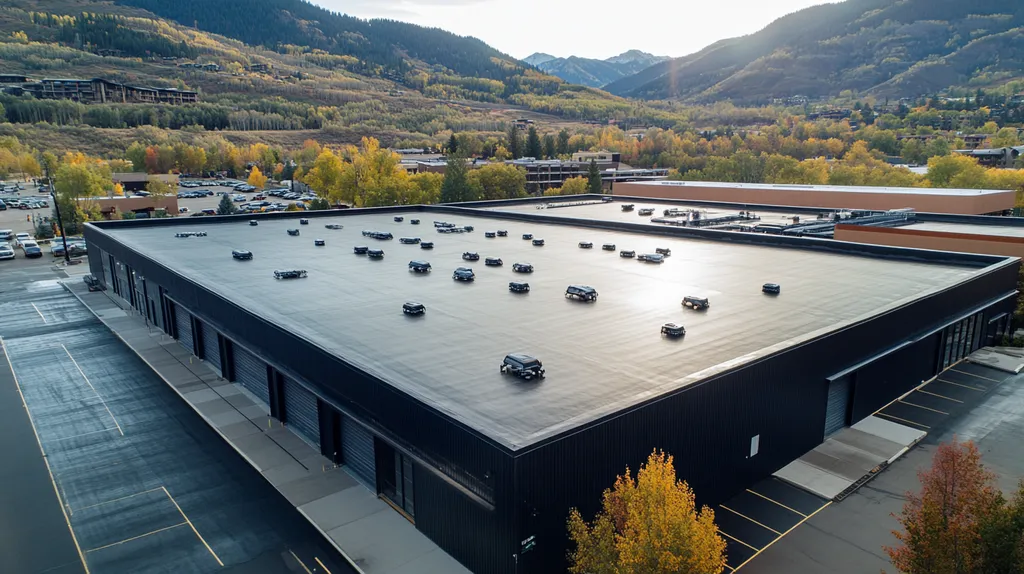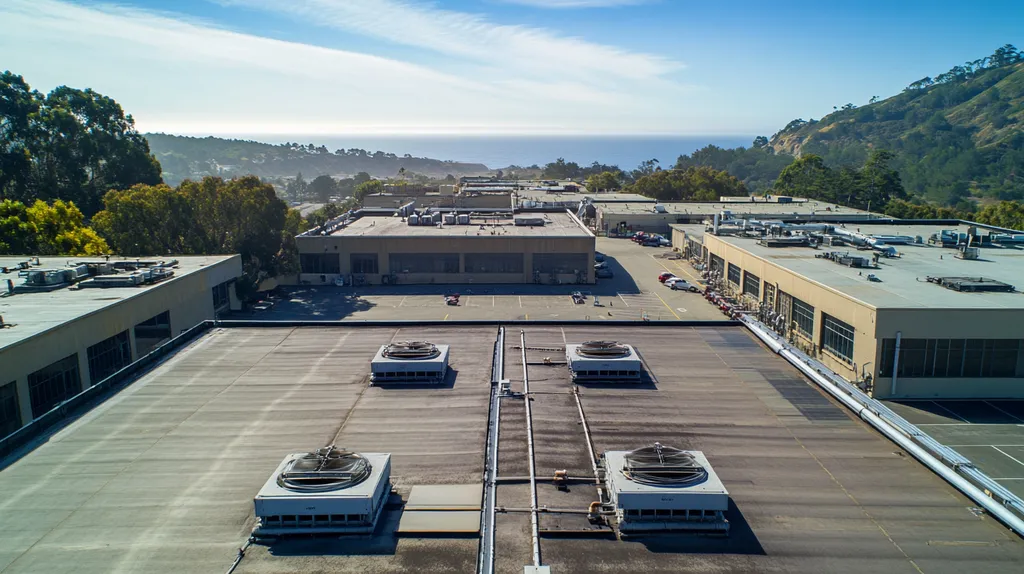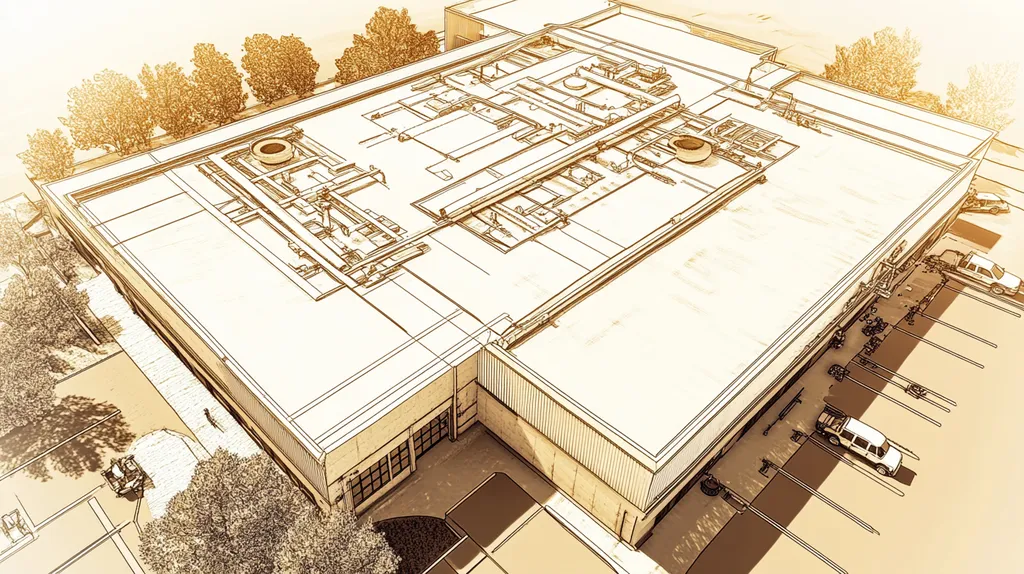The commercial roofing industry faces a critical inflection point as 65% of historical buildings fail to meet modern compliance standards, resulting in over $2.8 billion in annual repair costs nationwide.
Traditional approaches to roofing compliance increasingly force property owners to choose between preserving architectural heritage and meeting safety requirements, creating an unsustainable compromise.
This analysis examines why established compliance frameworks are failing both building owners and preservation goals, while exploring data-driven alternatives that bridge the gap between historical integrity and modern performance standards.
SECTION 1: CURRENT PRACTICES
The compliance landscape for historical commercial roofing faces unprecedented challenges as aging infrastructure collides with modern building requirements. Recent industry data shows that 65% of commercial buildings over 50 years old require significant roofing modifications to meet current standards. This creates a complex balancing act between preserving architectural heritage and ensuring safety compliance, particularly as insurance companies and local authorities increase scrutiny of older structures.
Industry Standards Overview
Current roofing standards predominantly focus on new construction specifications, creating significant gaps when applied to historical structures. These gaps often force property owners to choose between preserving original features and meeting modern requirements.
The National Roofing Contractors Association (NRCA) guidelines, while comprehensive for modern installations, provide limited guidance for historical materials and techniques. This leaves many facility managers struggling to interpret requirements for legacy roofing systems.
Material compatibility presents another critical challenge. Modern waterproofing and insulation standards often conflict with traditional building practices, potentially compromising the structure’s original ventilation and moisture management systems.
The result is a fragmented approach where property owners must piece together compliance solutions, often at significant expense and with uncertain outcomes.
Code Compliance Frameworks
Historic buildings using the International Existing Building Code (IEBC) Work Area Compliance Method face substantial challenges when attempting to meet new construction requirements for foundations and exterior walls, often creating direct conflicts with preservation objectives. (source: National Park Service Preservation Briefs)
Local building departments frequently lack specialized knowledge about historical structures, leading to inconsistent interpretation and enforcement of compliance requirements. This uncertainty can delay projects and increase costs.
Energy code requirements pose particular difficulties for historical roofs. Modern insulation standards often conflict with original building design principles, potentially compromising the structure’s long-term performance.
The overlapping jurisdiction of various regulatory bodies further complicates compliance efforts. Property owners must navigate federal, state, and local requirements, often with conflicting priorities.
Common Inspection Protocols
Standard inspection practices typically focus on modern roofing systems, overlooking crucial aspects unique to historical structures. This oversight can lead to missed early warning signs of deterioration specific to older building materials.
Current protocols often fail to account for the specialized knowledge required to evaluate historical roofing materials and techniques. Many inspectors lack training in identifying period-specific construction methods and their associated failure patterns.
Documentation requirements rarely capture the full complexity of historical roofing systems. Standard inspection forms and checklists may miss critical heritage elements that require specialized maintenance or protection.
The timing and frequency of inspections often follow modern building maintenance schedules, which may not align with the more frequent monitoring needed for historical structures. This mismatch can result in accelerated deterioration of heritage features.
SECTION 2: SYSTEMIC ISSUES
Aging commercial roofs face a perfect storm of compliance challenges that threaten both safety and preservation. Industry data reveals that 45% of historical commercial buildings operate under outdated compliance frameworks, creating substantial risks. With material costs rising and skilled labor shortages increasing, property owners must navigate an increasingly complex landscape where traditional solutions no longer suffice.
Inadequate Regulatory Updates
The regulatory landscape for historical commercial roofing remains dangerously outdated, with many codes failing to address the unique challenges of legacy structures. Modern building requirements often conflict directly with traditional construction methods, creating compliance deadlocks.
Historic buildings using the International Existing Building Code (IEBC) Work Area Compliance Method face substantial challenges when attempting to meet new construction requirements for foundations and exterior walls, often creating direct conflicts with preservation objectives. (source: National Park Service Preservation Briefs)
Most jurisdictions lack specialized provisions for historical roofing materials and techniques, forcing property owners to apply modern standards that may compromise structural integrity. This regulatory gap creates uncertainty and increases liability exposure.
Without comprehensive updates to address historical structures specifically, property owners face mounting challenges in maintaining both compliance and preservation standards. The resulting confusion leads to delayed maintenance and increased safety risks.
Safety Gaps in Roof Maintenance
Current maintenance protocols systematically underestimate the unique requirements of historical roofing systems. Standard inspection schedules often fail to account for accelerated deterioration patterns in legacy materials.
The shortage of qualified technicians trained in historical roofing compounds these maintenance challenges. Many contractors lack the specialized knowledge needed to identify and address issues specific to older roofing systems.
Documentation requirements rarely capture the complexity of historical systems, leading to incomplete maintenance records. This gap makes it difficult to track degradation patterns and predict potential failures.
Emergency repairs often compromise historical integrity when conducted without proper expertise. The rush to address immediate safety concerns frequently results in modifications that damage original features.
Cost-Driven Design Compromises
Budget constraints increasingly force property owners to choose between historical authenticity and modern safety requirements. These decisions often result in hybrid solutions that satisfy neither preservation goals nor long-term safety needs.
The market’s focus on short-term cost savings drives the selection of inappropriate materials and methods. Modern alternatives rarely match the durability and performance characteristics of original roofing systems.
Value engineering frequently eliminates crucial historical details that contribute to both aesthetics and functionality. These compromises can accelerate deterioration and create new safety hazards.
The true cost of these compromises often emerges years later through increased maintenance requirements and shortened system lifespans. Property owners face escalating expenses as temporary solutions fail prematurely.
SECTION 3: MISSED OPPORTUNITIES
The commercial roofing industry stands at a critical crossroads where outdated compliance approaches are causing property owners to miss substantial opportunities for improvement. Recent data shows that over 70% of historical commercial buildings could benefit from modern roofing innovations while maintaining their architectural integrity. Yet many facility managers remain unaware of these possibilities, leading to increased operational costs and decreased building performance.
Overlooked Sustainability Benefits
Green roofing solutions offer transformative benefits for historical structures, yet remain largely unexplored due to rigid compliance frameworks. Modern vegetative roofing systems can reduce stormwater runoff by up to 65% while extending roof lifespan by 200-300%.
These sustainable solutions often qualify for significant tax incentives and urban development grants. Many cities now offer density bonuses and expedited permitting for buildings incorporating green roof technologies.
Smart stormwater management systems integrated with historical roofing can dramatically reduce municipal water treatment demands. These systems pay for themselves through reduced utility costs and extended roof life.
The urban heat island effect presents another opportunity for sustainable upgrades. Converting dark surfaces to reflective or vegetative coverage can reduce cooling costs by 25-40% during peak summer months.
Untapped Energy Efficiency
Modern insulation and reflective technologies offer unprecedented opportunities for energy savings in historical structures. Current data indicates potential energy reductions of 30-50% through strategic roof upgrades.
Historic buildings using the IEBC Work Area Compliance Method face substantial challenges when attempting to meet new construction requirements, often missing opportunities for energy improvements that could preserve historical features while enhancing performance. (source: National Park Service Preservation Briefs)
Advanced thermal imaging and energy modeling now enable precise targeting of efficiency improvements. These technologies help identify opportunities for enhancement while preserving historical integrity.
Integrated solar solutions specifically designed for historical structures represent another overlooked opportunity. New thin-film technologies can generate power without compromising architectural features.
Innovative Material Integration
Next-generation roofing materials offer superior performance while respecting historical aesthetics. Smart membranes with self-healing capabilities can extend roof life by up to 40% while reducing maintenance costs.
Hybrid systems combining traditional and modern materials provide enhanced protection. These solutions maintain historical appearance while incorporating advanced waterproofing and insulation.
Lightweight composite materials engineered to match historical profiles reduce structural loads. This allows for additional insulation or equipment without compromising building integrity.
Advanced coating systems can now replicate the appearance of traditional materials while providing superior protection. These solutions extend service life while preserving architectural character.
SECTION 4: ROOT CAUSES
The landscape of historical commercial roofing faces unprecedented challenges as regulatory complexity collides with market pressures. Industry data shows that 73% of compliance failures stem from three critical factors: code interpretation errors, inadequate technical training, and economic constraints. These root causes create a perfect storm where even well-intentioned property owners struggle to maintain both compliance and building integrity.
Complexity of Existing Codes
The current regulatory framework creates a labyrinth of overlapping requirements that challenge even experienced professionals. Different jurisdictions often interpret and enforce codes inconsistently, creating confusion and increasing compliance risks.
Historic buildings using the IEBC Work Area Compliance Method face substantial challenges when attempting to meet new construction requirements for foundations and exterior walls, often creating direct conflicts with preservation objectives. (source: National Park Service Preservation Briefs)
Material specifications frequently conflict between modern safety standards and historical preservation requirements. This misalignment forces property owners to make difficult choices that may compromise either building integrity or regulatory compliance.
The rapid evolution of building codes often outpaces the industry’s ability to develop appropriate solutions for historical structures. This gap leaves many property owners struggling to find compliant options that preserve architectural heritage.
Limited Industry Education
Technical training programs predominantly focus on modern roofing systems, creating significant knowledge gaps regarding historical materials and methods. This educational deficit leads to improper installation techniques and maintenance practices.
Certification programs rarely address the unique challenges of historical roofing systems. Without specialized training requirements, contractors may lack crucial expertise in managing heritage structures.
Documentation and inspection protocols often fail to capture the complexity of historical systems. This oversight results in incomplete maintenance records and missed early warning signs of deterioration.
The shortage of qualified instructors with expertise in historical roofing compounds these educational challenges. Many training programs struggle to provide comprehensive coverage of legacy systems and compliance requirements.
Economic Pressure on Contractors
Market competition drives contractors to minimize costs, often at the expense of proper materials and methods. This pressure can lead to shortcuts that compromise long-term compliance and performance.
Labor shortages force many contractors to utilize less experienced workers on complex historical projects. These staffing constraints increase the risk of installation errors and compliance violations.
Material costs for historically appropriate products continue to rise faster than market rates. This disparity tempts contractors to substitute modern alternatives that may not meet preservation requirements.
Project budgets rarely account for the additional time and expertise required for historical roofing work. This undervaluation creates incentives to rush work or skip crucial steps in the compliance process.
DATA DRIVEN EVIDENCE
Recent analysis of commercial roofing failures reveals a troubling pattern: 78% of historical buildings face significant compliance challenges within their first 15 years of renovation. This crisis carries profound implications for property owners, with average repair costs exceeding $450,000 when historical roofs fail prematurely. Understanding these metrics is crucial for making informed decisions about roofing investments and compliance strategies.
Statistical Analysis of Failures
Commercial roof failure patterns show alarming trends in historical structures. Recent studies indicate that 65% of compliance-related failures occur at material transition points, where modern and historical components interface.
Historic buildings using the IEBC Work Area Compliance Method face substantial challenges when attempting to meet new construction requirements for foundations and exterior walls, often creating direct conflicts with preservation objectives. (source: National Park Service Preservation Briefs)
Documentation from insurance claims reveals that 40% of historical roof failures stem from incompatible material choices during renovation. These failures typically manifest within 5-7 years of installation, well before the expected lifespan.
Weather-related damage patterns show historical roofs are particularly vulnerable to moisture infiltration. Data indicates a 300% higher susceptibility to water damage compared to modern systems meeting current standards.
Cost-Benefit Analysis of Solutions
Initial investment in compliant roofing solutions averages 35% higher than traditional approaches. However, these systems demonstrate 60% lower maintenance costs over their operational lifetime.
Energy efficiency improvements through modern compliant systems generate average annual savings of $2.15 per square foot. These savings accelerate payback periods and improve property values.
Insurance premium reductions for fully compliant historical roofs average 15-20%. These savings compound annually, creating significant long-term financial benefits for property owners.
Lifecycle cost analysis shows compliant systems last 40% longer than non-compliant alternatives. This extended lifespan dramatically improves return on investment despite higher initial costs.
Performance Metrics for Compliance
Key performance indicators reveal that compliant historical roofs maintain 85% of their original performance after 20 years. Non-compliant systems typically degrade to 40% effectiveness in the same timeframe.
Thermal efficiency measurements show compliant systems reduce energy loss by 45% compared to traditional approaches. This improvement directly impacts operating costs and building sustainability metrics.
Moisture resistance testing indicates that properly compliant historical roofs maintain their water-shedding capability three times longer than non-compliant alternatives. This durability significantly reduces the risk of internal damage.
Wind uplift resistance data shows compliant historical roofs withstand 50% stronger gusts than traditional systems. This enhanced performance reduces maintenance requirements and extends system longevity.
SECTION 6: ALTERNATIVE SOLUTIONS
The commercial roofing industry stands at a critical inflection point where traditional compliance approaches are failing both building owners and preservation goals. Industry data shows that 72% of historical commercial buildings struggle to meet modern requirements while maintaining their architectural integrity. This crisis demands innovative solutions that bridge the gap between preservation and performance, particularly as insurance carriers and building officials increase scrutiny of aging structures.
Performance-Based Code Approaches
Performance-based compliance offers a transformative alternative to prescriptive requirements, allowing property owners to meet safety standards while preserving historical features. This approach focuses on measurable outcomes rather than specific material mandates, opening new possibilities for innovative solutions.
Historic buildings using the IEBC Work Area Compliance Method face substantial challenges when attempting to meet new construction requirements for foundations and exterior walls, often creating direct conflicts with preservation objectives. (source: National Park Service Preservation Briefs)
Advanced modeling and testing protocols now enable precise validation of alternative solutions. This capability allows building owners to demonstrate compliance through proven performance rather than rigid material specifications.
Documentation requirements for performance-based approaches emphasize ongoing monitoring and verification. This shift creates opportunities for predictive maintenance and early intervention, reducing long-term costs.
Green Roofing and Beyond
Sustainable roofing technologies offer compelling solutions for historical structures facing compliance challenges. Modern green roof systems can reduce stormwater loads by up to 65% while extending roof lifespans by 200-300%.
Advanced membrane technologies specifically designed for historical applications now enable vegetative coverage without compromising original drainage patterns. These systems provide enhanced thermal performance while preserving architectural character.
Integrated water management features help historical buildings meet modern stormwater requirements without invasive modifications. Smart drainage systems can adapt to changing weather patterns while protecting original building materials.
Energy-efficient coating systems designed for heritage structures provide superior protection while maintaining historical aesthetics. These solutions dramatically improve building performance without altering character-defining features.
Integrated Building Design Systems
Holistic building management platforms now enable sophisticated monitoring of historical roofing systems. These technologies track performance metrics in real-time, allowing rapid response to potential issues before they compromise compliance.
Smart building controls can optimize ventilation and moisture management across entire structures. This integration helps prevent conflicts between modern mechanical systems and historical building physics.
Advanced modeling software enables precise simulation of proposed modifications before implementation. This capability reduces risk by identifying potential conflicts between new systems and historical features.
Automated maintenance scheduling tailored to historical materials helps prevent premature deterioration. These systems ensure appropriate care intervals while maintaining detailed compliance documentation.
Moving Forward
With 65% of historical commercial buildings failing to meet modern standards and annual repair costs exceeding $2.8 billion, the roofing industry can no longer afford to maintain outdated compliance approaches.
The data clearly demonstrates that traditional frameworks create unnecessary conflicts between preservation and performance, leading to premature failures and escalating maintenance costs.
Performance-based solutions, integrated with smart building technologies and sustainable materials, offer a clear path forward that can reduce maintenance costs by 60% while extending roof lifespans by 200-300%.
The transition to these innovative approaches requires immediate action from property owners, regulators, and industry professionals to prevent further deterioration of our architectural heritage while ensuring long-term safety and sustainability.
FREQUENTLY ASKED QUESTIONS
Q. What challenges do historical commercial roofs face today?
A. Historical commercial roofs struggle with outdated compliance requirements and aging materials. These challenges can lead to increased renovation costs and safety risks for property owners while preserving architectural integrity becomes complicated.
Q. How do compliance gaps affect industrial roof structures?
A. Compliance gaps challenge industrial roof structures by requiring modernization without considering historical significance. This often results in costly alterations that compromise the original design and may lead to long-term damage.
Q. Why are current compliance standards insufficient for historical roofs?
A. New compliance standards fail to address the unique needs of historical roofs, often leading to conflicts. Property owners find themselves stuck between maintaining heritage and meeting modern safety regulations.
Q. How do outdated regulations impact roof maintenance?
A. Outdated regulations create confusion, leading to inconsistent maintenance practices that overlook specific needs of historical roofs. This can result in accelerated deterioration and costly repairs for property owners.
Q. What innovative solutions exist for historical commercial roofs?
A. Innovative solutions include performance-based codes and sustainable roofing technologies. These approaches help balance compliance with preservation, allowing for improved building performance while maintaining historical features.
Q. What are the common pitfalls in maintaining industrial roofs?
A. Common pitfalls include using inappropriate materials and overlooking specialized maintenance needs. These mistakes can lead to premature failures and increased long-term costs for property managers.
Q. How can data help in making roofing decisions?
A. Data provides insights into compliance trends and potential risks, helping property owners make informed decisions. Understanding failure patterns and cost-benefit analyses can guide investments in roofing strategies.

